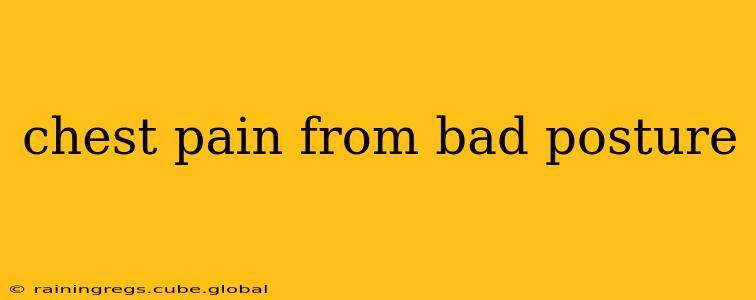Bad posture is a surprisingly common culprit behind chest pain. While serious heart conditions are a valid concern when experiencing chest pain, often the root cause is far less severe, stemming from musculoskeletal issues directly related to how we hold ourselves. This article will explore the link between bad posture and chest pain, delve into the potential causes, and offer solutions for relief and prevention.
How Does Bad Posture Cause Chest Pain?
Poor posture, particularly slouching or hunching, can lead to chest pain through several mechanisms:
-
Muscle Strain and Tension: Continuously slouching puts undue stress on the muscles in your chest, back, shoulders, and neck. This constant tension can lead to muscle spasms, stiffness, and pain radiating to the chest. The pectoralis muscles (chest muscles) can become tight and shortened, pulling on the ribs and causing discomfort. Conversely, weak back muscles fail to adequately support the spine, contributing to the problem.
-
Restricted Breathing: Poor posture can restrict your lung capacity. When your shoulders round forward and your chest collapses, it becomes harder to take deep breaths. This can lead to shortness of breath and a feeling of tightness or pressure in the chest, mimicking symptoms of other conditions.
-
Nerve Compression: Hunched posture can compress nerves in your neck and upper back. This nerve irritation can radiate pain down your arms and into your chest. This is particularly relevant in conditions like thoracic outlet syndrome.
-
Rib Subluxation: In some cases, poor posture can lead to minor misalignments of the ribs, causing pain and stiffness in the chest.
What are the Common Types of Chest Pain Related to Posture?
Chest pain associated with posture usually presents differently than pain related to heart conditions. It often feels:
- Aching: A dull, persistent ache in the chest, often localized to specific muscle groups.
- Sharp: Sharp, stabbing pain, particularly with movement or stretching.
- Tightness: A feeling of pressure or constriction in the chest, often relieved by changing posture.
- Referred Pain: Pain originating in the neck, shoulders, or back radiating to the chest.
Important Note: If you experience sudden, severe chest pain, especially accompanied by shortness of breath, sweating, or nausea, seek immediate medical attention. This article is for informational purposes and does not replace professional medical advice.
What Other Conditions Mimic Chest Pain from Bad Posture?
Several conditions can manifest as chest pain, making proper diagnosis crucial. These include:
- Costochondritis: Inflammation of the cartilage connecting the ribs to the breastbone.
- Musculoskeletal Injuries: Injuries to the chest muscles, ribs, or spine.
- Anxiety and Panic Attacks: These can cause chest tightness and pain.
- Gastroesophageal Reflux Disease (GERD): Acid reflux can cause chest pain that may be mistaken for heartburn.
A medical professional can distinguish between these conditions and posture-related pain through a physical exam and potentially imaging tests.
How Can I Tell if My Chest Pain is from Bad Posture?
It's difficult to self-diagnose, but here are some clues suggestive of posture-related chest pain:
- Pain is worse after prolonged periods of sitting or hunching.
- Pain improves with changes in posture (e.g., standing up straight, stretching).
- Pain is localized to the chest muscles or upper back.
- You have a history of poor posture.
- You experience neck and shoulder pain alongside the chest pain.
If you suspect your chest pain is posture-related, consult a doctor or physical therapist for proper diagnosis and treatment.
How Can I Treat Chest Pain Caused by Bad Posture?
Treatment focuses on improving posture and alleviating muscle tension. This typically involves:
- Postural Correction: Becoming more mindful of your posture throughout the day. Practice standing and sitting tall, engaging your core muscles.
- Stretching and Strengthening Exercises: Targeted exercises to stretch tight chest muscles and strengthen back and core muscles. A physical therapist can design a personalized program.
- Ergonomic Adjustments: Improving your workstation setup to promote good posture (e.g., proper chair height, monitor placement).
- Pain Management: Over-the-counter pain relievers like ibuprofen or naproxen can help manage pain and inflammation. In some cases, your doctor may prescribe stronger medication.
- Manual Therapy: Techniques like chiropractic adjustments or massage therapy can help alleviate muscle tension and improve joint mobility.
How Can I Prevent Chest Pain from Bad Posture?
Prevention is key! Here are some proactive steps:
- Maintain good posture: Regularly check your posture and make conscious corrections.
- Strengthen your core: A strong core provides better support for your spine.
- Stretch regularly: Include stretches for your chest, shoulders, and back in your daily routine.
- Exercise regularly: Physical activity helps maintain muscle strength and flexibility.
- Ergonomic workspace: Ensure your workspace is set up to support good posture.
- Take breaks: Regularly get up and move around, especially if you spend long hours sitting.
By understanding the link between bad posture and chest pain, adopting good postural habits, and seeking appropriate treatment when needed, you can significantly reduce your risk and improve your overall well-being. Remember, always consult with a healthcare professional for any persistent or concerning chest pain.
